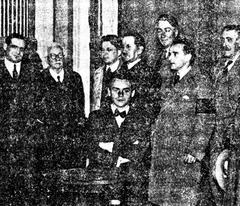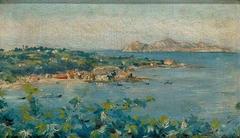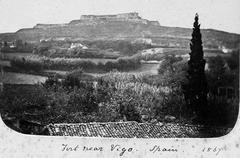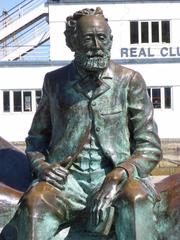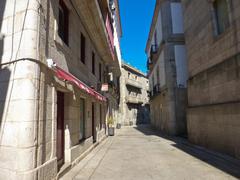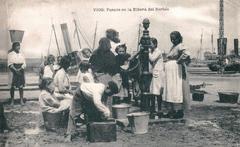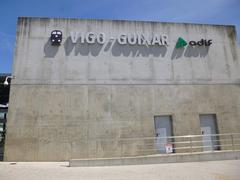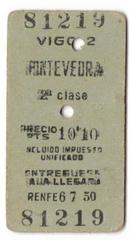
Casa de Correos e Telégrafos de Vigo: Visiting Hours, Tickets, and Travel Tips
Date: 04/07/2025
Introduction: The Significance of Casa de Correos e Telégrafos de Vigo
Located in the heart of Vigo, Spain, the Casa de Correos e Telégrafos de Vigo stands as an enduring symbol of the city’s transformation from a maritime town to a thriving urban center. This distinguished building, inaugurated in 1931, not only highlights Vigo’s architectural evolution but also marks a pivotal moment in Spain’s communication history. Designed by the renowned architect Manuel Gómez Román, the structure blends classicist, neobaroque, and regionalist styles, reflecting both national trends and the local Galician identity. As an active postal hub for nearly a century, it remains central to Vigo’s civic life and continues to connect the city with the rest of Spain and beyond.
Table of Contents
- Historical Context of Postal Services in Spain
- Conception and Construction of the Casa de Correos
- Architectural Highlights
- Role in Vigo’s Urban Development
- Visitor Information
- Accessibility and Nearby Attractions
- Contemporary Role of Correos y Telégrafos in Spain
- Frequently Asked Questions (FAQ)
- Conclusion and Final Tips
- References and Further Reading
Historical Context of Postal Services in Spain
Medieval Origins and Expansion
Spain’s organized postal system dates back to the Middle Ages, when royal messengers laid the groundwork for a centralized communication network. Over centuries, the system expanded to accommodate the needs of governance, commerce, and society. The introduction of prepaid postage in 1850 revolutionized mail, making the sender responsible for costs and greatly increasing usage. The telegraph arrived in Spain in 1852, rapidly connecting cities like Madrid and Irun, and, by the late 19th century, Spain’s communication infrastructure had grown to include thousands of kilometers of telegraph lines and a robust postal delivery network (Reference for Business).
Modernization and Institutionalization
With the onset of the 20th century, Spain’s postal services underwent major reforms. The formation of the Servicio de Correos y Telégrafos in 1909 marked the beginning of new services, such as savings accounts and postal money orders, and the introduction of airmail. By the 1930s, the organization managed thousands of offices and played a crucial socioeconomic role, managing a significant portion of the nation’s savings (Reference for Business).
Conception and Construction of Casa de Correos e Telégrafos de Vigo
Urban Aspirations and Design Competition
As Vigo expanded in the early 20th century, the city sought an emblematic building to house its growing postal and telegraph operations. Manuel Gómez Román won the 1920 design competition, proposing a building that would reflect Vigo’s ambitions and regional character. Construction began on the site of a former 18th-century customs house and was completed in 1929. The building officially opened after the completion of Calle Reconquista in 1931 (Wikiwand).
Architectural Highlights
Classicism and Regional Elements
The Casa de Correos exemplifies early 20th-century eclectic classicism, with influences from Antonio Palacios. The building features:
- Chamfered Corner Entrance: A defining semicircular arch serves as the main entrance, flanked by tall vertical windows and pilasters.
- Granite Façade: Local Galician granite imparts both character and durability.
- Neobaroque and Regionalist Details: Decorative “orejeras” (ear-shaped ornaments) and restrained postal emblems add a regional flair.
- Symmetrical Composition: The structure’s symmetry and proportion project civic dignity.
The interior, often glimpsed through the large glass entrance, is filled with natural light and preserves elements of its original grandeur (Wikipedia).
Role in Vigo’s Urban Development
Civic Progress and Urban Identity
Situated at the intersection of Plaza de Compostela and Calle Reconquista, the Casa de Correos marked Vigo’s integration into national communication networks and symbolized the city’s modernization. Its location in the Alameda district, surrounded by other significant early 20th-century buildings, underscores its status as a civic and architectural landmark (Turismo de Vigo, Loving Vigo).
Visitor Information
Address and Getting There
- Address: Praza de Compostela, 2, 36201 Vigo, Pontevedra, Spain
- Access: Easily reached by city bus, taxi, or on foot from central Vigo. The area is pedestrian-friendly and close to major attractions (Discovering Vigo).
Opening Hours and Tickets
- Hours: Monday to Friday, 8:30 AM – 8:30 PM; Saturday, 9:00 AM – 2:00 PM; closed Sundays and public holidays (Correos).
- Tickets: Entry is free. No ticket is required to visit public areas of the post office.
Guided Tours and Special Events
- Guided tours are occasionally held during cultural events or by arrangement with the local tourism office. Check the official Correos website or municipal information pages for updates (Ayuntamiento de Vigo).
Photography and Visitor Tips
- Photography is allowed in public areas; be respectful of ongoing postal operations.
- For optimal photos, visit during morning or late afternoon for the best natural light.
- Explore the main vestibule during business hours to appreciate the interplay of light and space.
Accessibility and Nearby Attractions
- Accessibility: The building is wheelchair accessible, with ramps and elevators for visitors with reduced mobility.
- Nearby Attractions:
- Plaza de Compostela: A lively square with cafes and gardens.
- Edificio Simeón & Edificio Mülder: Other architecturally significant buildings by Gómez Román.
- Casco Vello (Old Town): Historic streets, markets, and local shops.
- Local Walks: The Alameda district features additional early 20th-century architecture and is perfect for self-guided exploration (Turismo de Galicia).
Contemporary Role of Correos y Telégrafos
Correos remains Spain’s primary postal service provider, operating thousands of facilities and adapting to digital trends with online services and rural internet access points. The Casa de Correos de Vigo continues to function as a hub for mail, parcels, administrative procedures, and civic engagement (Correos, Reference for Business).
Frequently Asked Questions (FAQ)
Q: What are the Casa de Correos e Telégrafos de Vigo opening hours?
A: Monday to Friday, 8:30 AM – 8:30 PM; Saturday, 9:00 AM – 2:00 PM; closed Sundays and holidays.
Q: Is there an entrance fee or do I need a ticket?
A: No, entry is free as the building functions as a public post office.
Q: Are guided tours available?
A: Occasionally, during cultural events or by appointment with the tourism office.
Q: Is the building wheelchair accessible?
A: Yes, ramps and elevators are available.
Q: Can I take photographs inside?
A: Photography is permitted in public spaces; respect staff and privacy.
Q: How do I get there by public transport?
A: The building is centrally located and easily accessible by bus, taxi, or on foot.
Conclusion and Final Tips
The Casa de Correos e Telégrafos de Vigo is much more than a place to send letters—it is a living monument to the city’s civic ambition and architectural heritage. Its classicist design and regional details make it an essential stop for architecture enthusiasts, while its central location and accessibility invite all visitors to engage with Vigo’s history. Plan your visit during business hours, enjoy the surrounding Alameda district, and immerse yourself in the vibrant urban life of Vigo.
For the latest information, check the official Correos website, the Vigo tourism portal, or download the Audiala app for curated guides and updates.
References and Further Reading
- Correos y Telégrafos S.A. History, 2024, Reference for Business
- Casa de Correos y Telégrafos de Vigo, Wikiwand
- Vigo’s Past and Present, Turismo de Vigo
- Casa de Correos y Telégrafos de Vigo - Wikipedia
- La Casa de Correos y Telégrafos, Loving Vigo
- Ayuntamiento de Vigo
- Discovering Vigo
- Turismo de Galicia
- ScopeTrip
- OnlyByLand
Ready to explore more of Vigo’s architectural treasures? Download the Audiala app for guided tours, tips, and the latest updates on Vigo’s historical sites. Follow us on social media for more inspiration and news!


